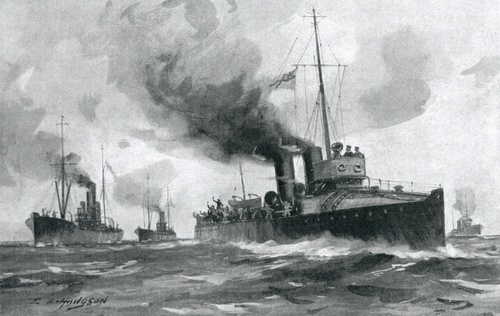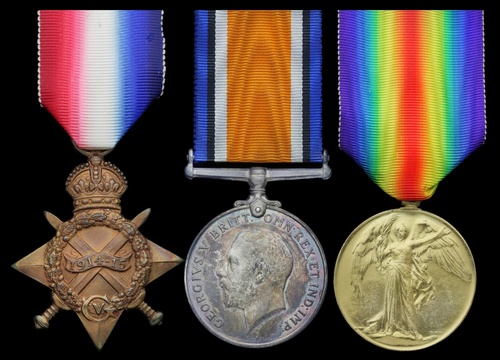Auction: 20001 - Orders, Decorations and Medals - conducted behind closed doors
Lot: 881
A rare Great War 'Thames Estuary' casualty group of three awarded to Stoker 2nd Class T. E. Griffiths, Royal Navy, who perished when the destroyer H.M.S. Recruit was struck by a torpedo launched by the German submarine U-6 which virtually cut her in two. The enemy submarine then rose to the surface and began shooting at survivors from its deck gun
This led to significant soul-searching amongst the crews of four British destroyers after they successfully destroyed two German torpedo boats in the vicinity later that afternoon and were faced with a similar scene of survivors struggling in the murky and choppy waters
1914-15 Star (SS.116020 T. E. Griffiths, Sto.2., R.N.); British War and Victory Medals (S.S.116020 T. E. Griffiths. Sto.2 R.N.), with three original paper packets, in named boxes of issue, extremely fine (3)
Thomas Edward Griffiths was born on 19 May 1891 at Stratford-on-Avon, Warwickshire, the second of nine children to Edward and Jane Griffiths of Howletts Hall, Freyerning, Essex. Thomas followed in his father's footsteps and worked locally as a cowman and farm labourer before enlisting into the Royal Navy on 17 September 1914. Sent to Pembroke II for training, he was posted to the ageing destroyer H.M.S. Recruit as Stoker 2nd Class on 30 December 1914.
An Unlucky Ship
A '30 knotter', Recruit was launched on 22 August 1896 and was armed with one 12-pounder gun, five 6-pounder guns and two 18-inch torpedo tubes. Her past was extremely chequered; during a steam trial on 3 April 1900 she collided with Wizard and had her propeller guard wrenched out. A short while later she ran into the Brambles Shoal, off Calshot Light, and suffered extensive damage during the 1901 naval exercises, and on 27 May 1902 she nearly foundered after running aground in heavy fog on the Verick Rock, a mile off Cape Cornwall. On this last occasion her crew were fortunate to reach the safety of Falmouth harbour, the holed destroyer being carefully brought into the Carrick Roads by tugs.
In April 1914, Recruit served as one of twelve destroyers of the Nore Local Defence Flotilla which guarded the mouth of the Thames Estuary, marking the point where the Thames meets the North Sea. Once again, misfortune was not far away; on 4 August 1914 she was struck by the German steamship Occident of Flensburg while on patrol. The collier made a hole level with the wardroom and only a rapid turn to starboard ordered by her Captain, Commander Charles. A. Wrightson, R.N., prevented the Recruit being cut in two.
A Running Fight - The Loss of H.M.S. Recruit
For four months, Griffiths was engaged aboard Recruit on repeated patrols against German U-Boats and torpedo boats as the Royal Navy attempted to safeguard the inshore merchant navy vessels which plied the east coast of England. The end of April 1915 witnessed a series of 'small affairs' in the southern reaches of the North Sea, when several steamers were attacked between the Galloper and North Hinder lightships (The Portsmouth Evening News, refers). On 1 May 1915, Recruit's luck finally ran out:
'The fight took place on Saturday and began at 11.30, when the old Recruit was on patrol duty. The weather was fine, the sea choppy, and a smart breeze was blowing. The Recruit was between two lightships when she spotted a periscope. It was quite near. Immediately the white trail of a torpedo darted across the water.
The Recruit at first steered straight for the submarine, but the torpedo caught her and dealt her a mortal wound. She heeled and began to sink fast. At a signal from her, the trawler Daisy approached, lowered boats, and sent them to the rescue. The officers and crew in the Recruit waited calmly for the Daisy's boats. The boats picked up many of the destroyer's crew, when the German seamen fired at the Daisy and at one of her boats which was filled with survivors. The Daisy managed to escape, but one of her boats was repeatedly fired on by the submarine, and one of the survivors in it was wounded' (The Portsmouth Evening News, 3 May 1915, refers).
Joined at the scene in the nick of time by the destroyers Laforey, Leonidas, Lawford and Lark, there followed a particularly vicious engagement which resulted in the sinking of two enemy torpedo boats:
'The fight was over at five o'clock. As the German boats went down the crews were rescued by the British seamen. Forty of the enemy were pulled out of the water alive and brought back to harbour early this morning. It is the old story. Our men were too humane to allow their enemies to perish. But there was bitter talk to-day as to what the Germans really deserved, especially when it became known how the submarine crew had treated the survivors of the Recruit' (The Portsmouth Evening News, continues).
Returning home with the survivors from Recruit and 41 enemy prisoners, the destroyers were cheered from the quayside. However, with tensions running high, one of the two German officers rescued from the sunken torpedo boats 'blew his brains out' with a revolver whilst aboard one of the British destroyers.
In total, 39 men died aboard Recruit, either as a result of the initial explosion or by drowning, including Stoker 2nd Class Thomas Edward Griffiths. Four officers and 21 men were saved by the trawler Daisy (The Hampshire Telegraph and Post, 7 May 1915, refers).
The submarine UB-6 which fired the fatal torpedo went on to account for 14 additional ships sunk, two ships damaged and one seized as a prize, and it was only a navigational error by her commander, Erich Haecker, which led to her final demise after running aground near the Maas River in the Netherlands. Likely trapped within the iron coffin of a rapidly-sinking destroyer, Griffith's body was never recovered and he is commemorated at Chatham Naval Memorial; sold with copied service record, extensive newspaper articles and research.
Subject to 20% VAT on Buyer’s Premium. For more information please view Terms and Conditions for Buyers.
Sold for
£240
Starting price
£110







